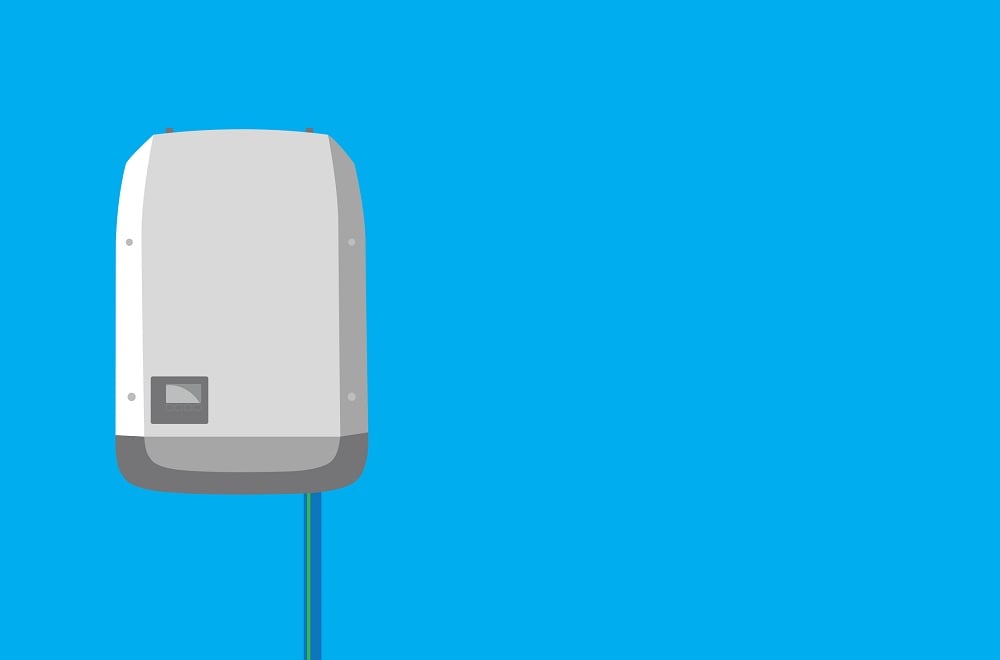Inverters have one of the most important jobs at a solar PV plant. They convert the DC power coming from the solar panels into AC power which is usable by the grid.
There are two main types of inverter design:
- Central inverters "centralize" the power produced by the plant and are extremely large, converting between 500 kilowatts to 2.5 megawatts each. Each power block at the plant will have one central inverter.
- String inverters use a distributed rather than centralized architecture, with a small inverter for smaller sections of the array. They convert much less power than a central inverter, but the advantage is that should an inverter fail, only the power from one small section is lost as opposed to an entire power block. Each power block at a solar PV plant consists of 10 string inverters.
"String or central inverters?" is one of the most common questions surrounding solar PV projects. It's an important one, since the inverter design has a major impact not only on the initial cost of a solar PV project, but on its long-term operating costs and performance.
Let's look at the string versus central inverters question in depth.
1. How do the two types of inverters compare in terms of cost?
The two inverter types are similar in terms of their initial equipment cost. Central inverters are much more expensive per unit than string inverters, but you need far fewer of them. For example, a smaller plant may need only one central inverter versus 10 or more string inverters.
The real cost difference depends on the amount of data central versus string inverters produce. Multiple string inverters produce more data points (also called "tags") for the SCADA system to pull in. This drives up the hardware, software, and implementation costs for the SCADA system.
How?
- You will need more processing power and hard drive capacity to handle and store the data, meaning higher hardware costs.
- It takes more labor from the SCADA provider to integrate the data points and map them into the HMI for monitoring.
- The licensing cost of SCADA, historian, and HMI software is typically tied to data points/tag count—the higher the tag count, the higher the cost.
From a SCADA perspective, string inverters have a higher upfront cost in terms of integration and the extra equipment needed to read the inverters.
Learn more: How Inverters Affect SCADA Cost
2. Are there any differences in terms of network considerations for either string or central inverters?
There are significant differences.
A distributed string inverter design is inherently more complex than a central inverter design. The more complex the design, the more difficult it is to network all of the inverters together and then link them back to the SCADA server. It is much easier to integrate a central inverter into the SCADA network than multiple string inverters.
To be more specific, each power block at a solar PV site has a single transformer that either connects to one central inverter or 10 string inverters. The string inverters typically connect serially to the power block, requiring an extra serial-to-ethernet protocol converter. This means your SCADA system must communicate with 10 different devices at that power block instead of a single ethernet connection to a central inverter. There's an extra protocol conversion that must happen.
3. Apart from cost, what are the benefits and drawbacks of using one design versus the other?
When it comes to the benefits and drawbacks of string versus central inverters, there are three key areas to consider: troubleshooting, performance, and the HMI.
Troubleshooting Considerations
From a SCADA perspective, it's easier to troubleshoot central inverters than string inverters. As discussed earlier, a more complex inverter design means a more complex network—and complex networks are harder to troubleshoot. You must deal with 10 devices at a power block instead of just one. There are more places things can go wrong and more possibilities to narrow down when trying to isolate the issue.
Central Versus String Inverter Performance
The complexity of a string inverter design can also slow down system response. The more devices you're talking to, the more latency you're going to have in the controls. Central inverters respond much faster to controls when compared to string inverters because you’re only sending commands to one inverter versus 10 per block.
HMI
String inverters each have a full set of data points versus just one set of points from central inverters. There are pluses and minuses to this. On the one hand, this gives you much more granularity in the data. On the other hand, it adds a lot of complication in terms of HMI and communication design. Instead of 40 data points to map into the HMI from the central inverters at four power blocks, you’ll have 400 with string inverters. This extra effort means more labor costs from the SCADA integrator.
4. What are some use cases when string is preferable to central, and vice versa?
Overall, it is more beneficial from a SCADA perspective to use central inverters over string inverters—for all the reasons covered above. As a SCADA integrator, that tends to be the lens we see through.
However, there are other perspectives to consider.
The O&M perspective on string versus central inverters can be very different. String inverters allow you to have a more granular view of what's going on in different parts of the plant. If you have a distributed site with a lot of variation—as opposed to a flat and level site—string inverters may be more beneficial.
Ultimately, the string versus central inverter question is one to be weighed by the owner, SCADA integrator, and O&M team on an individual basis for solar PV projects. There is no one definite answer that applies to every plant and every situation.
5. How do string and central inverters compare for O&M teams long term maintenance and operations management?
String inverters are only electrically connected to smaller parts of the PV array. If you need to do maintenance, you can turn off a single string inverter and only lose power from that small section. For central inverters, you would need to turn off the entire power block even if only a small portion of the block has a problem.
Alarm management also looks different for string versus central inverters. With string inverters you have more granularity and can see an alarm at the smaller string level rather than the larger power block level.
How can Nor-Cal Controls help with your solar PV project?
With over 12GW worth of successfully commissioned solar PV projects to date, we can advise on the inverter design that will provide cost efficiency and performance over the long term. Since our SCADA systems are based on open architecture hardware and software, we're agnostic when it comes to the inverters that are selected for our projects. You're never locked into one OEM or design.
Schedule a call with us today!





